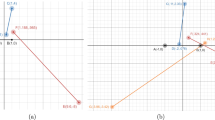Abstract
Given a set of pointsV in the plane, the Euclidean bottleneck matching problem is to match each point with some other point such that the longest Euclidean distance between matched points, resulting from this matching, is minimized. To solve this problem, we definek-relative neighborhood graphs, (kRNG) which are derived from Toussaint's relative neighborhood graphs (RNG). Two points are calledk-relative neighbors if and only if there are less thank points ofV which are closer to both of the two points than the two points are to each other. AkRNG is an undirected graph (V,E k r ) whereE k r is the set of pairs of points ofV which arek-relative neighbors. We prove that there exists an optimal solution of the Euclidean bottleneck matching problem which is a subset ofE 17 r . We also prove that ¦E k r ¦ < 18kn wheren is the number of points in setV. Our algorithm would construct a 17RNG first. This takesO(n 2) time. We then use Gabow and Tarjan's bottleneck maximum cardinality matching algorithm for general graphs whose time-complexity isO((n logn)0.5 m), wherem is the number of edges in the graph, to solve the bottleneck maximum cardinality matching problem in the 17RNG. This takesO(n 1.5 log0.5 n) time. The total time-complexity of our algorithm for the Euclidean bottleneck matching problem isO(n 2 +n 1.5 log0.5 n).
Similar content being viewed by others
References
Burkard, R. E., Derigs, U.,Assignment and Matching Problems: Solution Methods with FORTRAN Programs, Lecture Notes in Economics and Mathematical Systems, Vol. 184, 1980.
Gabow, H. N., A Scaling Algorithm for Weighted Matching on General Graphs,Proc. 26th Annual IEEE Symp. on Foundations of Computer Science (1985), pp. 90–100.
Gabow, H. N., and Tarjan, R. E., Algorithms for Two Bottleneck Optimization Problems,J. Algorithms,9 (1988), 411–417.
Katajainen, J., and Nevalainen, O., Computing Relative Neighborhood Graphs in the Plane,Pattern Recognition,19 (1986), 221–228.
Lawler, E. L.,Combinatorial Optimization: Networks and Matroids, Holt, Rinehart and Winston, New York 1976.
Toussaint, G. T., The Relative Neighborhood Graph of a Finite Planar Set,Pattern Recognition,12 (1980), 261–268.
Author information
Authors and Affiliations
Additional information
Communicated by C. L. Liu.
This research was partially supported by a grant from the National Science Council of the Republic of China under Grant NSC-78-0408-E-007-05.
Rights and permissions
About this article
Cite this article
Chang, M.S., Tang, C.Y. & Lee, R.C.T. Solving the Euclidean bottleneck matching problem byk-relative neighborhood graphs. Algorithmica 8, 177–194 (1992). https://doi.org/10.1007/BF01758842
Received:
Revised:
Issue Date:
DOI: https://doi.org/10.1007/BF01758842




